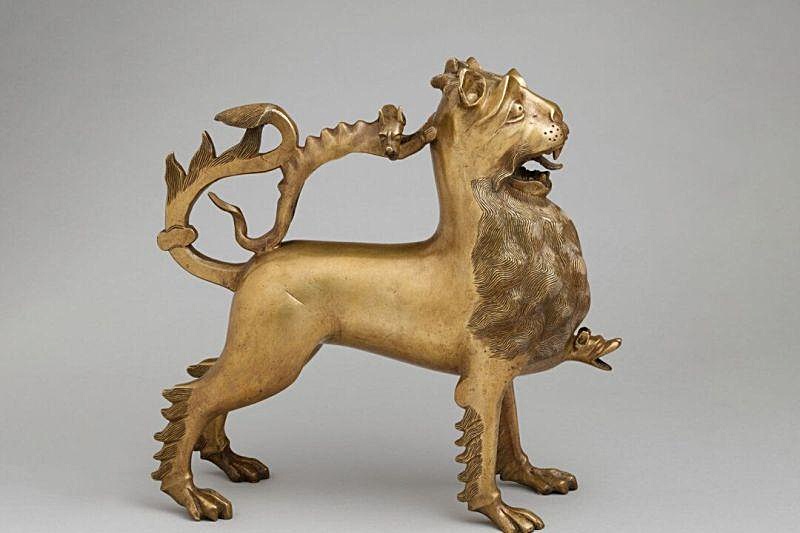Ritual hand-washing vessels known as aquamanilia played a crucial role in medieval Europe, serving both religious and secular purposes. Derived from the Latin words “aqua” (water) and “manus” (hand), aquamanilia were used by priests during liturgies to pour water and by aristocrats and wealthy merchants as ornamental pouring vessels during banquets.
Aquamanilia, the first vessels created during Europe’s Middle Ages, were typically made of copper alloy using the lost-wax process. Skilled artisans poured molten metal into a wax mold that was melted, leaving behind a cavity in the shape of the desired animal. Surface details were then engraved on the cast form. While hollow-cast animal receptacles existed in the later part of the Roman civilization and early Byzantine era, medieval aquamanilia are considered innovative adaptations rather than direct copies.
Hundreds of aquamanilia produced from the 12th to 15th centuries have survived to this day. The main manufacturing centers were in northern Germany, particularly Lower Saxony (circa 1200-1350), and the southern German city of Nuremberg (circa 1400).

Lions were the most common form of aquamanilia. Approximately one-third of the surviving aquamanilia depict these majestic creatures. Lions were highly symbolic during the Middle Ages, representing chivalry in heraldry and associated with Christ in religion. Over the centuries, lion aquamanilia were crafted in various forms.
The Metropolitan Museum of Art possesses one of the largest and most significant collections of aquamanilia, including an early North German example dating back to the 12th century. Made of copper alloy with glass inlays, it features the typical opening at the top of the lion’s head to fill the ewer with water, and a spout located in the animal’s mouth.
The Walters Art Museum houses an extraordinary lion aquamanile from the late 13th or early 14th century. This brass aquamanile bears a Hebrew inscription: “Blessed be the King of the Universe, who has instructed us to wash our hands.” It is believed to have been used for ceremonies in a synagogue or a Jewish home, possibly from Germany or the Netherlands.

In some instances, lions were combined with mythical creatures. The Art Institute of Chicago showcases an aquamanile from around 1325 to 1375 in the shape of a lion. This unique piece features a lion closing its jaws around a dog, with a serpentine creature forming its tail. The vessel’s handle is composed of a basilisk or a winged dragon.

A magnificent example of a hybrid lion aquamanile can be found at The Met Cloisters. It depicts a proud lion with a broad chest, majestic mane, and energetic body, likely cast in Nuremberg around 1400.


Attached to the same museum is a unicorn aquamanile, dated around 1425 to 1450, featuring a tail shaped like flames. This characteristic is common in Nuremberg-made aquamanilia. Notably, the vessel includes a spigot on the unicorn’s chest, suggesting its stationary nature. This feature became prevalent in aquamanilia produced after the 1400s.

The Met’s collection also boasts a griffin aquamanile from the same time period, likely made in the same workshop as the unicorn aquamanile. The griffin aquamanile is distinguished by its beautifully rendered outstretched wings, which were cast separately. This large aquamanile would have been a splendid table decoration during banquets, symbolizing wealth and opulence.

An exquisitely decorated griffin aquamanile, currently housed in the Museum of Fine Arts in Vienna, was used during Mass by a priest. Dating back to circa 1120-1130, this aquamanile is one of the earliest surviving examples. It was crafted using gilt bronze, garnet, damascened silver (a technique of inlaying silver into a darkened steel background), and niello (a black metallic compound used for design incision filling).

The cock, a significant motif in secular and religious art during the Middle Ages, found inspiration in various contexts such as Saint Peter’s denial of Jesus, medieval fables, and Chaucer’s “The Nun’s Priest’s Tale.”

Another notable aquamanile representing courtly life is that of a knight on horseback. These equestrian compositions feature realistic depictions of arms and armor. The Metropolitan Museum of Art presents a circa 1250 aquamanile in the form of a mounted knight, showcasing armor that can be dated by experts.

By exploring the aquamanile bestiary, one can uncover the playful side of medieval art intertwined with the era’s societal and religious customs. These aquamanilia, crafted with exceptional skill and artistic imagination, transcend their utilitarian nature to become objects of fine art.
Discover more from Tension News
Subscribe to get the latest posts sent to your email.

